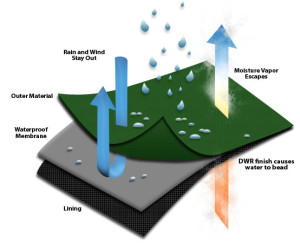 Sailing foul weather gear manufacturers spend a lot of time and effort generating marketing jargon to describe their garments. This article is a brief introduction to the different types of materials used in constructing waterproof outerwear. It will give you a base knowledge that you can use to compare garments between manufacturers, without relying on their often vague and hyperbolic product descriptions.
Sailing foul weather gear manufacturers spend a lot of time and effort generating marketing jargon to describe their garments. This article is a brief introduction to the different types of materials used in constructing waterproof outerwear. It will give you a base knowledge that you can use to compare garments between manufacturers, without relying on their often vague and hyperbolic product descriptions.
PVC
PVC is the material of choice for commercial fishermen, less so for sailing foul weather gear. It’s waterproof, durable, and cleans up easily. It’s also relatively inexpensive. The downside to PVC is its lack of breathability. It’s forgivable when you are able to quickly hose the fish guts off your bibs at the end of the day, but harder to live with when you’re cruising for multiple days or racing, and your sweat has nowhere to go.
Polyurethane (PU)
This is the workhorse material for sailing foul weather gear. Polyurethane works by soaking up your sweat, and your body heat pushes it through the fabric to the outside, where it is exposed to the environment and evaporates. Pay attention to whether the PU is coated or laminated. Coated polyurethane garments (where the coating is spread on the face fabric) are cheaper to make, but less durable and heavier. Laminated polyurethane garments (where the PU laminate is bonded to the face fabric with heat) are more durable and lighter, but more costly. Polyurethane coatings tend to have a tacky feel, which can reduce comfort in unlined garments. PU laminates are much better in this regard.
ePTFE (GORE-TEX, eVent)
High-end foul weather gear uses some variant of ePTFE (Teflon) as its waterproof/breathable layer. This material has millions of tiny pores, large enough for water vapor (sweat) to pass through, but too small for liquid water to penetrate from the outside. It’s breathability is notably higher than PU-based materials, and it also has an edge in comfort and durability. Gore-Tex is a combination of ePTFE and a PU layer, while eVent fabrics are only ePTFE (with some other secret voodoo). The best material, predictably, comes at the highest price. However, if you’re a competitive racer or long-distance cruiser, it is money well spent.
Durable Water Repellant (DWR)
This is a PTFE (Teflon) coating that is applied to the face fabric on waterproof garments. It performs a similar task to the wax on your car, causing water to bead and run off the fabric, rather than soaking in. Keeping the face fabric as dry as possible is important to the proper operation of any of the waterproof/breathable materials. Without the DWR, the face fabric would quickly saturate and the breathability of the garment would be reduced drastically. The DWR can normally be rejuvenated by putting the garment in a clothes dryer for a few minutes. If that doesn’t do the trick, you can get spray-on or wash-in DWR products, such as Nikwax or 303 Fabric Guard.